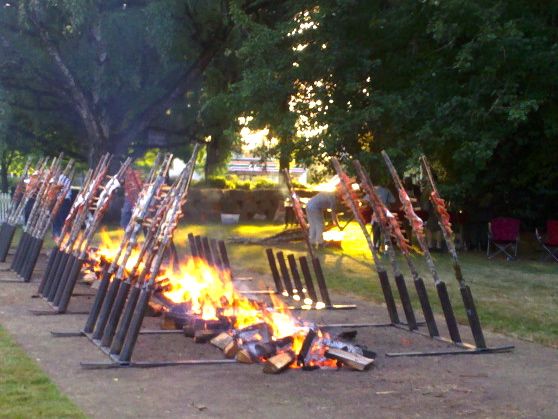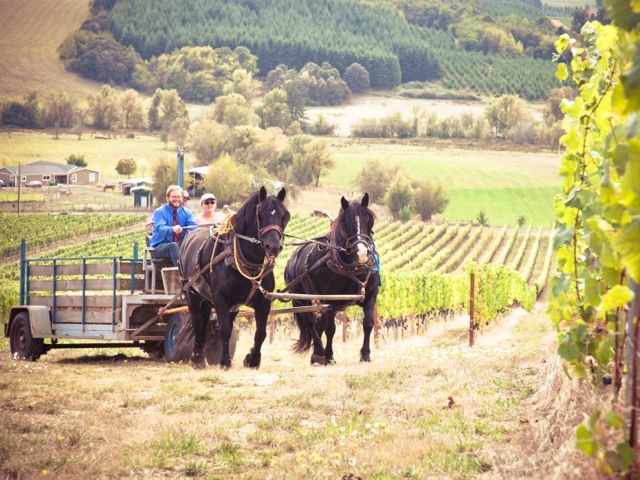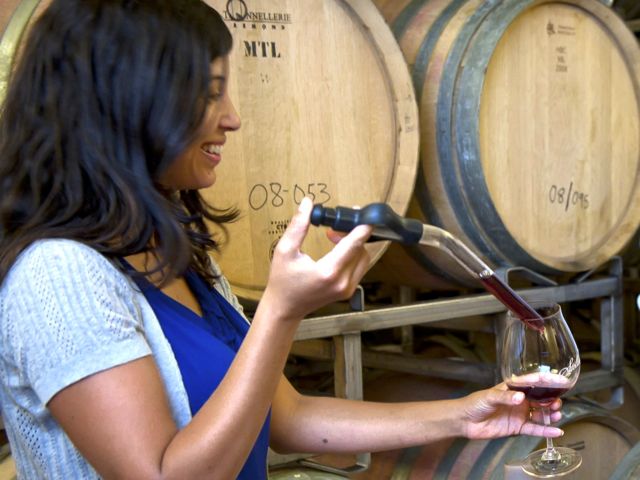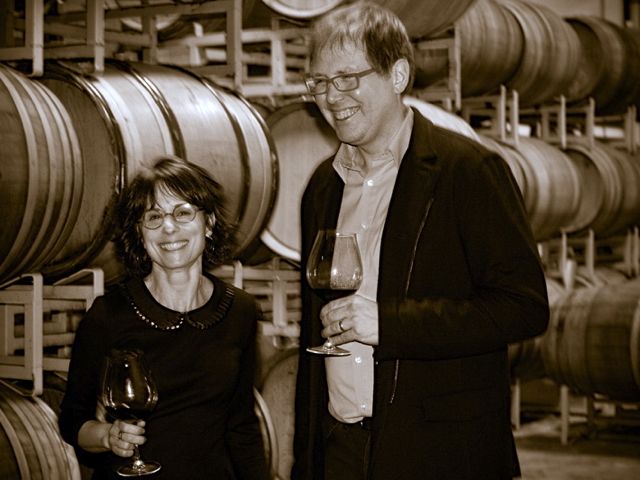
salmonbake, l
(article, Kerry Newberry)
[%adInjectionSettings noInject=true][%pageBreakSettings nobreak=true] As the sun dips a little earlier each night and fall draws near, I find myself musing over one of my favorite quotes by the poet Wallace Stevens: '“The On a summer's eve, time slows down. The sunset lingers, and so does the conversation around the dinner table, which is often moved outside. A summer night brings fireflies and cricket serenades, campfires and starlit toasts. [%image salmonbake float=right width=400 caption="Fish on sticks: The Salmon Bake at the International Pinot Noir Celebration."] Or, if you happen to attend the Saturday-night Salmon Bake at the International Pinot Noir Celebration in McMinnville, Oregon, the summer fête is shimmering leaves in a grove of ancient oaks and the aroma of alder-smoked salmon. Perfection of thought realized. Tables stretch beneath sun-dappled trees, and pinot noir purists from France and Oregon, New Zealand and California mingle in the crowd, pouring their heart’s work from this notoriously fickle yet lyrical grape. The pinot pours well after dusk by lantern light and luminous globes that crisscross the grove. A classic food-and-wine match — salmon and pinot noir — stars at the Salmon Bake, an event that stimulates all the senses. The fire pit, about 40 feet long by 15 feet wide, feels almost primal and crackles well into the night. The conviviality grows with each cin-cin as more than 800 pinot noir lovers clink glasses to meet and greet new friends. The Salmon Bake is rooted in local Native American tradition. “It celebrates the bounty of the season and the return of the salmon, which was a mainstay for local tribes,” says Jason Stoller Smith, the executive chef at Timberline Lodge. “It’s very visual. And you can smell it. It’s exciting,” he adds. Oregon pinot noir and alder-smoked salmon are a quintessential Pacific Northwest pairing, and the Salmon Bake is a revelry of both. “Salmon and pinot are cut from the same cloth,” says Smith. "Kind of the yin and the yang of each other as far as food and wine." While the pairing is perfect all year long, I can’t help but want to capture one more fleeting summer night that evokes the idyllic oak grove with friends old and new. Luckily, Smith says the Salmon Bake is easier than you think to recreate at home. (See his tips, below.) “What I suggest is saving it for a night that is a celebration and having a party with good friends," he says. "That way, when the fish is taking a bit longer, everyone agrees to settle in and open another bottle of wine.” The wine, of course, should be an Oregon pinot noir. Here are five Oregon pinot noir producers that were featured at the 2012 IPNC, each representing the heart of what defines Oregon wine — from sustainability pioneers and small family wineries to urban winemakers paving a new path for pinot production in the city of Portland. h3. Bethel Heights [%image bethelheights float=right width=400 caption="Ben and Mimi, the cousins behind Bethel Heights."] When I think of Oregon pinot, I think of small family wineries producing elegant, ethereal wines. One that always comes to mind is Bethel Heights, founded in 1977 by twin brothers Terry and Ted Casteel and their wives. Today, the second generation has stepped into the family-run winery, with Ben Casteel as winemaker and his cousin Mimi managing the estate vineyards. (Side note to cider lovers: Mimi and her husband, Nick Gunn, are also partners in Wandering Aengus Ciderworks.) Try the 2009 Willamette Valley Pinot Noir ($28): silky red fruit, rose petals, and a true reflection of the beauty of Oregon pinot. h3. Boedecker Cellars [%image boedeckers float=right width=400 caption="Athena and Stewart Boedecker, his-and-her winemakers."] I’ve heard that the secret to success for all great relationships is the art of compromise. Meet Athena and Stewart Boedecker, husband-and-wife winemakers with two different palates. Stewart likes one style of pinot, Athena likes another. So, when the time came to blend their first vintage in 2003, the art of compromise led to two defining bottles for two distinct tastes. The he-said-she-said tradition continues today. Each Boedecker vintage includes a Willamette Valley blend made in the style each winemaker prefers. For Athena, the wine is reflective; for Stewart, transparent. Try the Athena, 2009 Willamette Valley Pinot Noir ($34) or the Stewart, 2009 Pinot Noir ($34). Both wines are food-friendly with round plush earthy cherry notes. An urban winery, Boedecker Cellars is a must-visit in Portland, set in the NW Industrial district. h3. Et Fille Wines [%image etfille float=right width=400 caption="Howard Mozeico and Jessica Mozeico-Blair"] Boutique, hands-on, and family-run is also what you’ll find at Et Fille. Et Fille, which means "and daughter," honors the hand-in-hand, father-and-daughter team of Howard Mozeico and Jessica Mozeico-Blair. After Jessica fell for wine on a family trip to Burgundy, it became a shared passion and an important part of family dinners for her and her father. At the time, Howard was working full time as a software engineer, taking winemaking classes and helping at wineries in the area. The "aha" moment came in 2003 when, after encouraging her father to follow his dream of running a winery, daughter Jessica suggested they run one together. Try the 2009 Kalita Vineyard pinot noir ($38), with its rich cherry and plum notes. If you appreciate illustrious descriptors (as I do), check out the fun tasting notes by father and daughter on their website — food pairing ideas included. The Kalita, for example, is likened to a Jimmy Choo strappy sandal, and pairs with lamb or short ribs. h3. Illahe Vineyards & Winery [%image Illahe float=right width=400 caption="Doc and Bea, the draft horses of Illahe."] If you visit Illahee Vineyards during harvest, you might spot Doc and Bea, a team of stately Percheron draft horses delivering grapes to the winery. In spring, the pair mows the cover crops between rows of grapes. While green vineyard and winery practices abound in Oregon, only a handful of wineries are using draft horses in West Coast vineyards. Winemaker Brad Ford first envisioned horses working the vineyard five years ago, when his closest neighbor — a cattle rancher and horseman — would canter by on horseback with his daughters. The winemaker saw hoof power as a means to reduce tractor runs and to minimize soil impaction: “We would be able to limit our diesel use, and it would be an attractive thing for people to come and see.” Illahe Vineyards and Winery is also a family affair. Brad’s father, Lowell, first planted grape vines on their property in 1983 and still manages the vineyard. Try the 2010 Illahe Pinot Noir ($20), with its lush and earthy blackberry fruit on the palate. And think of the beauty of what horsepower represents: time. It's a reminder to slow down, which is a good thing. h3. Stoller Family Estate [%image stoller float=right width=400 caption="Winemaker Melissa Burr of Stoller Family Estate."] When I have out-of-town visitors, Stoller is one spot I love to take them. Stoller is a 373-acre property in the heart of the Willamette Valley Wine Country with nearly 200 acres of grapevines, mostly pinot noir and chardonnay. The renowned vineyard began as a turkey farm; in 1995, after the decline of the turkey industry, the Stoller family planted their first 20 acres of grape vines. Ten years later, they designed and built the first LEED Gold-certified winery in the United States, a state-of-the-art facility that is a wonder to see. The winery is also one of a few that features a Vineyard Stay where oenophiles can slumber surrounded by grape vines. Try the 2009 JV Estate Pinot Noir ($25) — earthy, soft ripe cherry with light floral notes. h4. Salmon-bake tips from Jason Stoller Smith “All you need is a wood fire and a sapling that’s about 2½ inches wide and about four to five feet long. Split the sapling down the middle with a saw about three-fourths of the way down. Tie a wire at the bottom of the cut part to keep it from splitting further. Next, add some cedar splints that run across to help support the weight of the fish. You'll want to soak the splints in water so they don’t catch on fire. "When you're ready to go, season the salmon and place it in between the splint saplings with the cedar crosslings supporting the weight. Mount it over the fire and let it cook slowly. The salmon can take 45 minutes to cook, depending on so many things — the wind, the size of the salmon.” [%image salmonprep width=600 caption="Salmon prep."]

salmonbake, l

Illahe, l

salmonprep, l

etfille, l

stoller, l

bethelheights, l

boedeckers, l

reference-image, l

featurette-image, l